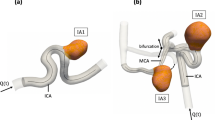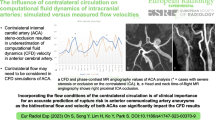Abstract
Background
Flow patterns in cerebral aneurysms are clinically important. Information on inflow patterns into aneurysms is especially helpful in preventing a recurrence after coil embolization. Computational fluid dynamics (CFD) simulations of patient-specific cerebral aneurysms are feasible and provide information on flow patterns. However, flow visualization by CFD simulations is challenging for recurrent aneurysms after coil embolization because coils make it difficult to obtain precise geometry of the recurrent aneurysms. In this study, we assessed the feasibility of flow visualization of recurrent aneurysms using 3D phase-contrast magnetic resonance imaging (PC-MRI).
Method
Time-of-flight magnetic resonance angiography and 3D PC-MRI were performed in eight cases of recurrent aneurysms after coil embolization. We attempted to visualize flow inside the aneurysms using data of 3D PC-MRI and evaluated the visualization. Additionally, CFD simulations were performed in a single case.
Results
Inflow into aneurysms was visualized in all eight cases (100 %). Flow patterns inside aneurysms were visualized in six cases (75 %), and these were associated with a large size of recurrent aneurysms (mean size, 10.3 mm for visualized cases vs. 4.8 mm for unvisualized cases; p = 0.046, Mann–Whitney test). Flow patterns were similar between PC-MRI and CFD simulations. PC-MRI was faster and easier for observing inflow patterns than CFD simulations.
Conclusions
This is the first study to demonstrate that flow visualization of recurrent aneurysms by 3D PC-MRI is feasible. This technique may be more practical and easier than CFD simulations, and may provide clinically helpful information.


Similar content being viewed by others
References
Cebral JR, Mut F, Weir J, Putman CM (2011) Association of hemodynamic characteristics and cerebral aneurysm rupture. AJNR Am J Neuroradiol 32:264–270
Gao B, Baharoglu MI, Cohen AD, Malek AM (2012) Stent-assisted coiling of intracranial bifurcation aneurysms leads to immediate and delayed intracranial vascular angle remodeling. AJNR Am J Neuroradiol 33:649–654
Graves VB, Strother CM, Duff TA, Perl J (1995) Early treatment of ruptured aneurysms with Guglielmi detachable coils: effect on subsequent bleeding. Neurosurgery 37:640–647
Hoi Y, Woodward SH, Kim M, Taulbee DB, Meng H (2006) Validation of CFD simulations of cerebral aneurysms with implication of geometric variations. J Biomech Eng 128:844–851
Huang QH, Wu YF, Xu Y, Hong B, Zhang L, Liu JM (2011) Vascular geometry change because of endovascular stent placement for anterior communicating artery aneurysms. AJNR Am J Neuroradiol 32:1721–1725
Hyogo T, Kataoka T, Hayase K, Nakamura H (2001) Angiographical follow-up results of cerebral aneurysms treated by Guglielmi detachable coil system. Interv Neuroradiol 7:137–142
Isoda H, Ohkura Y, Kosugi T, Hirano M, Alley MT, Bammer R, Pelc NJ, Namba H, Sakahara H (2010) Comparison of hemodynamics of intracranial aneurysms between MR fluid dynamics using 3D cine phase-contrast MRI and MR-based computational fluid dynamics. Neuroradiology 52:913–920
Isoda H, Ohkura Y, Kosugi T, Hirano M, Takeda H, Hiramatsu H, Yamashita S, Takehara Y, Alley MT, Bammer R, Pelc NJ, Namba H, Sakahara H (2010) In vivo hemodynamic analysis of intracranial aneurysms obtained by magnetic resonance fluid dynamics (MRFD) based on time-resolved three-dimensional phase-contrast MRI. Neuroradiology 52:921–928
Kono K, Fujimoto T, Shintani A, Terada T (2012) Hemodynamic characteristics at the rupture site of cerebral aneurysms: a case study. Neurosurgery 71:E1202–E1209
Kono K, Shintani A, Fujimoto T, Terada T (2012) Stent-assisted coil embolization and computational fluid dynamics simulations of bilateral vertebral artery dissecting aneurysms presenting with subarachnoid hemorrhage: case report. Neurosurgery 71:E1192–E1201
Kono K, Shintani S, Terada T (2014) Retreatment of recanalized aneurysms after y-stent-assisted coil embolization with double enterprise stents: case report and systematic review of the literature. Turk Neurosurg 24:593–597
Kono K, Terada T (2013) Hemodynamics of 8 different configurations of stenting for bifurcation aneurysms. AJNR Am J Neuroradiol 34:1980–1986
Kono K, Tomura N, Yoshimura R, Terada T (2013) Changes in wall shear stress magnitude after aneurysm rupture. Acta Neurochir (Wien) 155:1559–1563
Lorensen WE, Cline HE (1987) Marching cubes: a high resolution 3D surface construction algorithm. ACM Siggraph Comput Graph 21:163–169
Luo B, Yang X, Wang S, Li H, Chen J, Yu H, Zhang Y, Zhang Y, Mu S, Liu Z, Ding G (2011) High shear stress and flow velocity in partially occluded aneurysms prone to recanalization. Stroke 42:745–753
Naito T, Miyachi S, Matsubara N, Isoda H, Izumi T, Haraguchi K, Takahashi I, Ishii K, Wakabayashi T (2012) Magnetic resonance fluid dynamics for intracranial aneurysms–comparison with computed fluid dynamics. Acta Neurochir (Wien) 154:993–1001
Shimai H, Yokota H, Nakamura S, Himeno R (2005) Extraction from biological volume data of a region of interest with non-uniform intensity. Optomechatronic Techn 2005:605115
Steinman DA, Hoi Y, Fahy P, Morris L, Walsh MT, Aristokleous N, Anayiotos AS, Papaharilaou Y, Arzani A, Shadden SC, Berg P, Janiga G, Bols J, Segers P, Bressloff NW, Cibis M, Gijsen FH, Cito S, Pallarés J, Browne LD, Costelloe JA, Lynch AG, Degroote J, Vierendeels J, Fu W, Qiao A, Hodis S, Kallmes DF, Kalsi H, Long Q, Kheyfets VO, Finol EA, Kono K, Malek AM, Lauric A, Menon PG, Pekkan K, Esmaily Moghadam M, Marsden AL, Oshima M, Katagiri K, Peiffer V, Mohamied Y, Sherwin SJ, Schaller J, Goubergrits L, Usera G, Mendina M, Valen-Sendstad K, Habets DF, Xiang J, Meng H, Yu Y, Karniadakis GE, Shaffer N, Loth F (2013) Variability of computational fluid dynamics solutions for pressure and flow in a giant aneurysm: the ASME 2012 Summer Bioengineering Conference CFD Challenge. J Biomech Eng 135:021016
van Ooij P, Schneiders JJ, Marquering HA, Majoie CB, van Bavel E, Nederveen AJ (2013) 3D cine phase-contrast MRI at 3T in intracranial aneurysms compared with patient-specific computational fluid dynamics. AJNR Am J Neuroradiol 34:1785–1791
Conflict of interest
We declare that we have no conflicts of interest.
Author information
Authors and Affiliations
Corresponding author
Rights and permissions
About this article
Cite this article
Kono, K., Terada, T. Flow visualization of recurrent aneurysms after coil embolization by 3D phase-contrast MRI. Acta Neurochir 156, 2035–2040 (2014). https://doi.org/10.1007/s00701-014-2231-5
Received:
Accepted:
Published:
Issue Date:
DOI: https://doi.org/10.1007/s00701-014-2231-5




